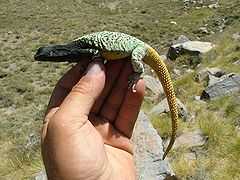Phymaturus
| Phymaturus | |
|---|---|
 | |
| Adult male of Phymaturus verdugo | |
| Scientific classification | |
| Kingdom: | Animalia |
| Phylum: | Chordata |
| Subphylum: | Vertebrata |
| Class: | Reptilia (paraphyletic) |
| Subclass: | Diapsida |
| (unranked): | Sauria |
| Infraclass: | Lepidosauromorpha |
| Superorder: | Lepidosauria |
| Order: | Squamata |
| (unranked): | Toxicofera |
| Suborder: | Iguania |
| Family: | Liolaemidae (disputed) |
| Genus: | Phymaturus |
| Diversity | |
| 20 species | |
Phymaturus is a genus of iguanian "lizards" of the family Liolaemidae, which is traditionally included in the Iguanidae as subfamily but more recently was proposed to warrant distinct family status. It is the mid-sized genus of its family, with 20 species altogether known as of 2008; new species are still being discovered however.[1]
They are found in the Andes region south to Patagonia and inhabit a variety of habitats. Their habits are mostly conserved from the ancestral iguanians, insofar as that Phymaturus are generally inhabitants of rocky ground that feed on plants and give birth to fully developed young.[1]
Systematics
The genus can be divided into two lineages, which probably represent clades:
flagellifer group
- Superciliar scales not imbricate, more than four subocular scales, 3-4 rows of lorilabial scales, mental scale narrower than rostral scale and usually touching the sublabial scales. Tail spines well-developed, two annuli per segment.[1]
- Phymaturus antofagastensis Pereyra, 1985
- Phymaturus flagellifer (Molina, 1782) (= P. palluma)
- Phymaturus mallimaccii Cei, 1980
- Phymaturus punae Cei, Etheridge & Videla, 1983
- Phymaturus roigorum Lobo & Abdala, 2007
- Phymaturus verdugo Cei & Videla, 2003
- Phymaturus vociferator Pincheira-Donoso, 2004 (= P. dorsimaculatus)
patagonicus group
- Superciliar scales elongate and overlapping, one usually unfragmented subocular scale, tail smooth, Meckel's groove fused and closed.[1]
- Phymaturus agilis Scolaro, Ibargüengoytía & Pincheira-Donoso, 2008 (formerly in P. spectabilis)
- Phymaturus calcogaster Scolaro & Cei, 2003
- Phymaturus ceii Scolaro & Ibargüengoytía, 2007
- Phymaturus delheyi Avila et al., 2011[2]
- Phymaturus excelsus Lobo & Quinteros, 2005
- Phymaturus extrilidus Lobo et al., 2012
- Phymaturus indistinctus Cei & Castro, 1973
- Phymaturus nevadoi Cei & Castro, 1973
- Phymaturus patagonicus Koslowsky, 1898
- Phymaturus payuniae Cei & Castro, 1973
- Phymaturus sitesi Avila et al., 2011[2]
- Phymaturus somuncurensis Cei & Castro, 1973
- Phymaturus spectabilis Lobo & Quinteros, 2005
- Phymaturus spurcus Barbour 1921
- Phymaturus tenebrosus Lobo & Quinteros, 2005
- Phymaturus zapalensis Cei & Castro, 1973
Footnotes
References
- Avila, Luciana Javier; Perez, Cristian Hernan Fulvio; Perez, Daniel Roberto & Morando, Mariana (2011): Two new mountain lizard species of the Phymaturus genus (Squamata: Iguania) from northwestern Patagonia, Argentina. Zootaxa 2924: 1-21 [English with Spanish abstract]. PDF abstract
- Scolaro, José Alejandro; Ibargüengoytía, Nora Ruth & Pincheira-Donoso, Daniel (2008): When starvation challenges the tradition of niche conservatism: On a new species of the saxicolous genus Phymaturus from Patagonia Argentina with pseudoarboreal foraging behaviour (Iguania, Liolaemidae). Zootaxa 1786: 48-60 [English with Spanish abstract]. PDF abstract